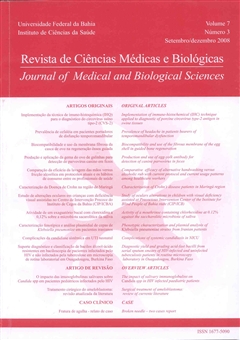Prevalence of headache in patients bearers of temporomandibular dysfunction
DOI:
https://doi.org/10.9771/cmbio.v7i3.4460Keywords:
Temporomandibular dysfunction- Headache, Headache- Temporomandibular joint.Abstract
Temporomandibular dysfunction (DTM) described for a set of signs and symptoms, being headache, one of symptoms more commom. The objective from this research is to estimate the prevalence of headache among bearers of temporomandibular dysfunction. For this, it was realized the review of dossiers of patients with DTM; it was observed reports of complaint headache, its localization and the kind of introduction, presence of pain from muscles palpation, age and sex of patients. From 232 analyzed dossiers, 163 (70,25%) have manifested headache, being 143 (74,87%) of female sex. The age group more affected by headache was from 33 to 83 years-old, representing 87 (75,65%) patients. From patients with headache, 74,61% represented pain in masticatory and/or neck musculature, and 78,72% had pain in one muscle. In the localization of muscles pain and headache, 76,07% had pain in temporal muscle and 58,28% headache in temporal area; 59,33% had headache in only one area in the head. As for kind of representation of headache, 80,90% described the headache of one form, being the narrow more frequent (12,26%). The conclusions are that the high prevalence of headache is among DTM porters, being important to realize more explicated researches of cohesion among thematics.Downloads
Download data is not yet available.
Downloads
Published
2008-04-04
How to Cite
Requião, F. M. O., & Macedo, C. R. S. de. (2008). Prevalence of headache in patients bearers of temporomandibular dysfunction. Journal of Medical and Biological Sciences, 7(3), 220–227. https://doi.org/10.9771/cmbio.v7i3.4460
Issue
Section
ORIGINAL ARTICLES
License
The Journal of Medical and Biological Sciences reserves all copyrights of published works, including translations, allowing, however, their subsequent reproduction as transcription, with proper citation of source, through the Creative Commons license. The periodical has free and free access.


